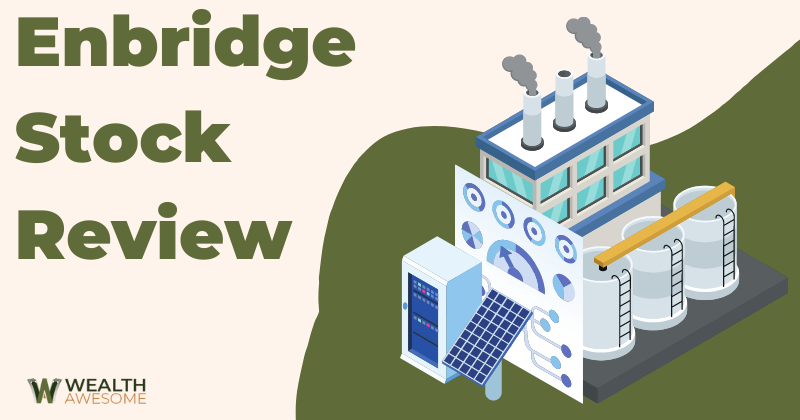Canada is one of the largest oil producers globally and has the third-largest energy reserves globally, making about 10% of the global reserves. The bulk of Canadian energy goes to just one consumer – the US.
Thanks to geographical proximity and extensive pipeline networks, Canada is able to ship off the majority of oil and gas produced here.
As the largest pipeline company in Canada and the US, Enbridge stock is a critical player in this area.
Resilient And Generous Dividend Aristocrat
The competitive advantage, diversified businesses, and resilience regarding dividend growth make Enbridge a no-brainer reliable dividend buy.
Features And Benefits
History
Enbridge started as Interprovincial Pipe Line Company or IPL in 1949 as a regional pipeline company, moving crude from Alberta to Regina.
It extended to the US in 1960 through a subsidiary. The company was transporting more than a billion barrels a day by 1972.
A massive addition to its portfolio was in 1996 when it acquired the largest natural gas distribution company in Canada (now part of Enbridge Gas).
It got the name Enbridge in 1998, and it kept growing organically and through acquisition.
The last major milestone was Enbridge’s acquisition of Spectra Energy, making it the largest energy infrastructure company in North America.
Market, National, and International Presence
Enbridge is the energy transportation leader in North America and one of the largest pipeline companies in the world.
After Russia’s Transneft, Enbridge controls the most extensive pipeline length in the world (roughly 12% of the total energy pipeline length in the world).
It’s the largest energy company in Canada by market cap and one of the largest in North America.
The company has distinct strengths in all four of its major business segments:
Liquid Pipelines: Enbridge has a liquid pipeline network of 28,661 km, roughly half of which are in the US. The company transports about three million barrels a day (crude and other liquids) and 30% of all the crude produced in North America. Every four out of ten barrels of crude oil that enter the US come via Enbridge.
Natural Gas Transmission: The natural gas network is even more impressive, i.e., 123,189 km (ten systems), connecting 30 US states and five Canadian provinces. This allows it to move one-fifth of the natural gas consumed in the US.
Natural Gas Utility: Thanks to its business customers, Enbridge is the top natural gas utility company in North America by volume, though third when it comes to several consumers. Three out of four people in Ontario get their natural gas from Enbridge, and it has 3.9 million connections in Quebec as well.
Renewable Energy: Enbridge has been into renewables since 2002. Thanks to its investments in 23 wind farms and 17 solar farms, it has a net production capacity of 2,172 MW, enough to power about 962,000 homes.
Simply put, Enbridge is a giant with a relatively diversified business model and an impressive US presence.
Risk Profile

Enbridge is the energy leader of the country, i.e., the largest energy company in Canada by market cap.
This affords it a decent amount of stability. However, Enbridge’s business model is a more significant point in its favour:
Energy Transportation. This makes it different from many other energy giants in the country, many of which are energy producers.
An energy producer is financially vulnerable to price fluctuations. If the oil price is high, oil production and processing are profitable.
When the price dips, the profit starts shrinking since the companies spend the same amount of money mining and processing a barrel of oil but getting less for it.
It’s an oversimplification, especially considering oils futures are bought months in advance, but it usually is how investors perceive these energy companies.
As a pipeline/energy transportation company, Enbridge’s finances are not as vulnerable to price fluctuations.
The company has relatively long-term contracts in place, usually with fixed, predictable prices that don’t change until the contract is renewed.
That said, Enbridge is still not immune to sector dynamics. The stock fell quite hard in 2015 when the energy sector in Canada saw a massive decline.
And now, when the energy sector is experiencing a bullish phase, Enbridge is riding the growth train as well.
However, there is usually a slight delay in both, Enbridge stock following the sector upward or downward.
Metrics To Look For

Payout Ratio: As a dividend company, the payout ratio is quite important to ascertain dividend sustainability, though it doesn’t work as neatly with Enbridge since its payout ratio has been below 100% just once in the last ten years. A year-to-year comparison is still valid.
Revenue: A stability or modest revenue growth is always desirable. If there is a massive quarter-over-quarter revenue decline, it might indicate that the company is not getting as many or as lucrative transportation contracts, which might make the dividends unsustainable.
Dividends

Dividends are one of the primary reasons investors love Enbridge. That’s because:
- Enbridge offers a yield that’s much higher than the bulk of dividend aristocrats in the country and typically higher than similar energy giants.
- While its payout ratio is usually above 100% (which doesn’t bode well for financial stability), the company has sustained its payouts for a long time and through crises, most recently in 2015 and 2020.
- The dividend growth rate has been quite decent for the last few years, though the company is planning to cap dividend growth for the foreseeable future, likely to result in better payout ratios. However, it will still be enough to outpace inflation, encouraging people to invest in this energy giant for a long-term dividend income stream.
The company has grown its payouts for 27 consecutive years, making it a dividend aristocrat by Canadian and US standards, which is about 5x more stringent.
Also, it has been paying dividends for 67 years. The company is well-positioned to reach the dividend king status by completing 50 years of consecutive dividend increases.
Stock Performance

Enbridge stock performance has two different phases. It was a continuously growing stock before 2015 and grew almost 290% in the decade between 2005 and 2015.
Since 2015, the stock has been more cyclical, though even the best growth spurt out of three didn’t reach past 64%.
The best you can do is buy the dip, which is brilliant from a dividend perspective and hold on for as long as possible.
Enbridge Stock Forecast 2025
Assuming the current bullish phase lasts till 2025 (a strong possibility is oil demand doesn’t slump), the stock may trade in mid $80s.
If it continues with the current cyclical pattern, the top $60s or early $70s is the best you might hope for. But even at its worst, the probability of Enbridge stock falling below $45 (by 2025) is relatively low.
Enbridge Stock Alternatives And Competitors
Enbridge Stock vs. TC Energy Stock
The main difference between the two is that TC Energy leans more heavily towards natural gas.
Its gas pipeline network is several times larger than the crude network and is responsible for the bulk of its revenue. Its 2015 decline was not as harsh, and subsequent recovery has been better than Enbridge.
Its payout history is more stable, the dividend yield is just slightly lower, and capital appreciation potential is a shade better than Enbridge, though it doesn’t have the utility business presence or renewable focus that Enbridge has.
Enbridge Stock vs. Suncor Stock
Suncor used to be just as beloved a dividend stock as Enbridge, but it broke its dividend growth streak during the pandemic.
As a fully integrated energy business, it’s fundamentally different from Enbridge, which mainly offers midstream services.
Suncor does it all, from extracting oil and product (mainly from oil sands) to refining and selling it through its impressive network of gas stations, which offers it more exposure and more vulnerability to oil prices.
Out of the two, Enbridge is less risky and offers better yield and dividend sustainability potential.
FAQs
Q-1: Is Enbridge A Good Long-Term Holding?
Ans.: Enbridge is an intelligent long-term holding, thanks mainly to its impressive dividends.
Q-2: Are Enbridge Dividends Safe?
Ans.: Enbridge has sustained its payouts even in some of the harshest markets, and it’s taking more forceful measures to keep its dividends financially sustainable in the future, so yes, Enbridge dividends are pretty safe.
Conclusion

Enbridge is a safe bet, as long as the oil demand doesn’t permanently slump down, which may take several decades to even gain proper traction.
Even then, its natural gas and other businesses can sustain the company and its dividends and offer it a fighting chance.
As one of the most generous and resilient dividend aristocrats, Enbridge Stock gets a warm Wealthawesome (warmed using Enbridge’s gas) thumbs up!





